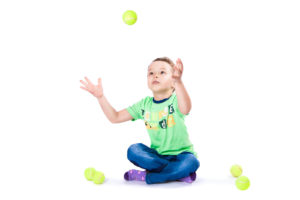
Eye Conditions That Can Be Addressed with Vision Therapy
We’ve thrown this stat at our readers more times than we can count, but it’s just such a pertinent one that we’re going to give it to you one more time: Did you know that 80 percent of all learning is visual? We’ve also talked a lot about vision therapy, but what eye conditions can it actually help?
Though this statistic refers mostly to classroom learning, it does speak to something bigger. Most of our world is visual, both inside and outside of the classroom. That means having optimal vision is crucial to navigating the world.
But what happens when eyeglasses or contact lenses aren’t enough to get you through the day? What if you’re just tired of having to depend on external products to correct your vision?
Well, then vision therapy may be the solution for you. When corrective eyewear isn’t enough, vision therapy may be just what you need to correct your specific eye condition.
What Is Vision Therapy and How Does It Help Eye Conditions?
Unlike the eye exercises you do at home, which aim to strengthen your eye muscles, vision therapy consists of using personalized techniques to target specific vision problems.
Vision therapy is a drug-free and non-invasive alternative to treating certain eye conditions. The procedures are safe for both children and adults. Vision therapy comes highly recommended for children who have vision developmental issues.
For the most part, vision therapy is done in an office where a session can last anywhere from 30 minutes to an hour. Depending on your program, you may have to go in for these sessions once or twice a week. In between sessions, you’ll be assigned at-home vision therapy “homework”, if you will.
These sessions will continue until you’ve reached your goal for your vision, whether that takes two weeks or a year is up to you and your commitment to the program.
Vision Therapy and Eye Conditions It Treats
There are some things that eyeglasses and contact lenses can’t improve or correct. For those things, vision therapy can definitely help. Vision therapy looks to sharpen those eye skills that are perhaps underdeveloped or you’ve lost from not working on them.
Here are four vision conditions that can be addressed with individualized vision therapy programs:
Focusing Problems
Our eyes are equipped with automatic focusing, just like a camera. This allows us to see things clearly at any distance. However, some people don’t have this feature. It is often underdeveloped in children. This can cause an inability to change focus quickly from near to distant objects very difficult.
Focusing problems can cause several side effects like blurred vision, trouble with reading and writing, eye strain, a decrease in productivity, headaches, and fatigue. For school children and office workers alike, sharp focusing skills are a must for learning and productivity.
Often, this condition is treated with corrective eyewear, but it isn’t always effective or convenient. Vision therapy techniques can help with focusing problems. Vision therapy will train the eyes by forcing them to focus quicker on objects at different distances.
Depth Perception Problems
Our depth perception is what allows us to gauge the distance between us and our surroundings and between objects and other objects. It is a crucial skill that humans since the dawn of time have relied on for survival.
Though we do not need our depth perception for the same sort of survival our cavemen ancestors did, it is still a much-needed sense.
Our depth perception is courtesy of our ability to see in three dimensions, which is called stereoscopic vision. When someone is lacking or missing stereoscopic vision, this can make perceiving depth very difficult. They may rely on other visual cues to see depth, but their perception of it is much less accurate.
If a person is lacking in three-dimensional vision; there is no way to cure that. But vision therapy can definitely help to better identify those other visual cues that do signify depth.
Vision therapy is really about working with what you’ve got. If you don’t have stereoscopic vision to rely on for visual cues, then you have to work the cues you do have! Depth perception can be easily improved with vision therapy sessions.
Hand-Eye Coordination Problems
 We all know that one person with absolutely zero hand-eye coordination and who always literally drops the ball during your tag football game. Though it’s fun to laugh at how terrible they are at football, it is actually a hard thing to live with.
We all know that one person with absolutely zero hand-eye coordination and who always literally drops the ball during your tag football game. Though it’s fun to laugh at how terrible they are at football, it is actually a hard thing to live with.
Your hand-eye coordination is the ability of your brain to effectively and quickly communicate visual information with your hands, arms, legs, feet, etc. Without it, things like playing sports, drawing, and riding a bike are all very difficult to execute because the brain and visual information are out of sync.
Like with the previously mentioned problems, vision therapy can help to train those underdeveloped hand-eye coordination skills. This will help your brain and body become more in tune with each other for better communication and eventually better task execution.
Hand-eye coordination is an especially valuable skill for children. A childhood without sports is a sad one. Vision therapy for hand-eye coordination in children will allow them the freedom of good vision without glasses and will set them up for healthier eyes as they grow older.
Strabismus or Crossed Eyes
Strabismus, or crossed eyes, is a condition that affects a lot of children and adults. This condition refers to the crossing of the eyes and the drifting of the eyes outwards. If not treated early in children, strabismus can cause a lifetime of poor vision and vision problems.
Even though vision therapy for children with strabismus is available, it is more of a bonus. There are more effective ways to treat infant strabismus. Instead, vision therapy for strabismus mainly helps adults whose condition has become almost permanent.
For adults, surgery is the only other option to treat their strabismus. However, vision therapy success stories claim that their vision has significantly improved without the use of dangerous and invasive surgery.
Vision therapy is something that everyone should look into, even if they don’t have existing eye conditions or problems. Your eyes will benefit from the therapy no matter what. There isn’t anything wrong with a little eye training.
Our Rebuild Your Vision Ocu-Plus Formula Contains All 17 Vitamins, Minerals, and Herbal Supplements to Improve Your Eye Health!












I had lazy eye as a child which never improved. I had surgery on the eye in 1987 which reversed the condition temporarily but was improved with bochelin injections to the inner muscle. This was successful for many years. However, the eye drifted back to the post-surgery condition which caused double vision. I have tried eye exercises with little or no improvement. I now have a prism in both lenses to help improve the condition. This is not that effective either and I have to struggle to overcome the double vision. I am 72 now. My eyedoctor doesn’t recommend surgery or the buchelin injection as an option. What do you recommend that I do next?
Section talks about therapy but not how or where?
Where does one find vision therapy?
Do you have any info on narrow angle glaucoma? And are there any non surgical solutions?
This was interesting but I did not see anything about the diabetic low vision that I have. Do you have anything about that ?
As a seventy plus person with failing long distant vision